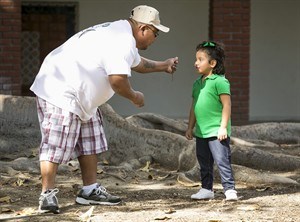
In this photo taken Feb. 11, 2015, Santos Lopez crushes a tree leaf for his daughter, Angelica Lopez, 3, so she can experience the sound. Angelica was born deaf and received an auditory brainstem implant to allow her to hear some sounds. She is part of a research study of the device in youngsters at the University of Southern California. U.S. researchers are implanting a device on the brain stems of a small number of deaf children to see if it will help them learn to hear. The studies are aimed at children who don’t have working hearing nerves and thus don’t qualify for a more common technology, cochlear implants. The implants stimulate brain cells that those nerves normally target.
Image Credit: AP Photo/Damian Dovarganes
February 14, 2015 - 8:23 AM
WASHINGTON - At age 3, Angelica Lopez is helping to break a sound barrier for deaf children.
Born without working auditory nerves, she can detect sounds for the first time — and start to mimic them — after undergoing brain surgery to implant a device that bypasses missing wiring in her inner ears.
Angelica is one of a small number of U.S. children who are testing what's called an auditory brainstem implant, or ABI. The device goes beyond cochlear implants that have brought hearing to many deaf children but that don't work for tots who lack their hearing nerve.
When the ABI is first turned on, "she isn't going to be hearing like a 3-year-old. She'll be hearing like a newborn," audiologist Laurie Eisenberg of the University of Southern California tells parents. She outlined the research Friday at a meeting of the American Association for the Advancement of Science.
The children don't magically understand and use those sounds. "It's going to take a lot of work," Eisenberg cautioned.
Angelica cried when her ABI first was switched on, scared by the sounds. But five months later, her mother says the youngster uses sign language to identify some sounds — that was a cough, that's a dog barking. And she's beginning to babble like hearing babies do, as therapists work to teach her oral speech.
"It's just so awesome to hear her little voice," said Julie Lopez of Big Spring, Texas, who enrolled her daughter in the study at USC, where researchers say she's progressing well.
Many children born deaf benefit from cochlear implants, electrodes that send impulses to the auditory nerve, where they're relayed to the brain and recognized as sound. But the small fraction born without a working hearing nerve can't make that brain connection.
The ABI attempts to fill that gap by delivering electrical stimulation directly to the neurons on the brainstem the nerve normally would have targeted. Here's how it works: The person wears a microphone on the ear to detect sound, and a processer changes it to electrical signals. Those are beamed to a stimulator under the skin, which sends the signals snaking through a wire to electrodes surgically placed on the brainstem.
The Food and Drug Administration approved the device in 2000 specifically for adults and teenagers whose hearing nerves had been destroyed by surgery for a rare type of tumour. It doesn't restore normal hearing, but can help to varying degrees.
Then about a decade ago, an Italian surgeon started trying the ABI in deaf children, whose younger brains are more flexible and might better adapt to this artificial way of delivering sound.
Now, spurred by some successes abroad, the first U.S. studies in young children are underway at a handful of hospitals. Hearing specialists are watching the work closely.
There are children "who are not being helped in any other way," said Dr. Gordon Hughes of the National Institutes of Health, which is funding Eisenberg's study. And cochlear implants proved "there's a critical time window when the brain is very receptive to auditory stimulation and can develop speech communication in ways that are surprisingly good, if the stimulation is started early enough."
The studies are small, each enrolling 10 to 20 children. Ages vary; the Los Angeles study will implant starting at age 2, while some others try earlier. Children then receive intensive therapy, to learn to hear.
The studies must prove safety, since the ABI requires delicate brain surgery in healthy children.
"We're talking about real surgery to go into a deep area of the brain," said Dr. Marc Schwartz, a neurosurgeon with the House Clinic and Huntington Medical Research Institutes in Los Angeles, who is part of the USC study. "This is a precise operation that requires exacting technique."
In skilled hands, complications appear rare, said Robert Shannon, a USC professor of otolaryngology who helped develop the device. Post-surgery, stimulator complications can include non-auditory sensations such as tingling of the face or throat.
Next questions include who are the best candidates, and what benefit to expect — if children really will develop speech as well as with cochlear implants, and hear well enough to talk on a phone. Scientists know far more about how to stimulate the inner ear than the brain directly, Shannon noted.
"What we're giving to these kids is something very different than what any normal system would be getting," he explained. To untangle that scrambled pattern, "the brain is picking up the slack. It's covering our tracks."
News from © The Associated Press, 2015